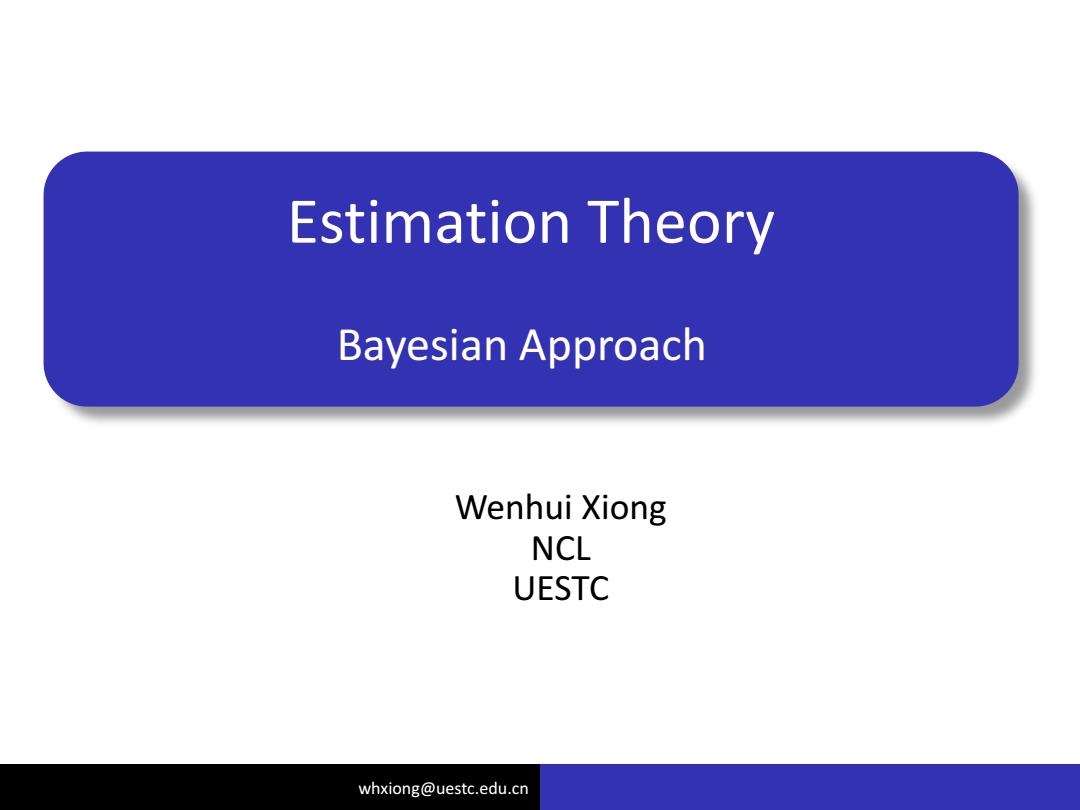
Estimation Theory Bayesian Approach Wenhui Xiong NCL UESTC whxiong@uestc.edu.cn
whxiong@uestc.edu.cn Estimation Theory Bayesian Approach Wenhui Xiong NCL UESTC

Review Estimator CRLB→factorize alnp(x:0) 80 =I(9)(g(x)-8) RBLS: .Use sufficient statistics:T(x)ET(] unbiased estimator over sufficient statistics:g[T(x)] ● BLUE:if the unknown is a linear function of the data ●MLE:known PDF 。Least Square Assumption:unknown is deterministic whxiong@uestc.edu.cn 2
whxiong@uestc.edu.cn Review Estimator 2 CRLB factorize RBLS: Use sufficient statistics: T(x) unbiased estimator over sufficient statistics: g[T(x)] BLUE: if the unknown is a linear function of the data MLE: known PDF Least Square E[µ · jT(x)] Assumption: unknown is deterministic @lnp(x; µ) @µ = I(µ)(g(x) ¡ µ)

Bayesian Approach How about:the unknown is a random variable 0 If the information about the rV is known,the estimator do better? Example:Estimating DC in WGN cn =A+wln whxiong@uestc.edu.cn 3
whxiong@uestc.edu.cn 3 Bayesian Approach How about: the unknown is a random variable If the information about the RV is known, the estimator do better? Example: Estimating DC in WGN x[n] = A + w[n]

Bayesian Approach How about:the unknown is a random variable If the information about the RV is known,the estimator do better? Example:Estimating DC in WGN xIn =A+wln 。MVU:sample mean A=元AW(A,σ2/N) whxiong@uestc.edu.cn 4
whxiong@uestc.edu.cn 4 Bayesian Approach How about: the unknown is a random variable If the information about the RV is known, the estimator do better? Example: Estimating DC in WGN x[n] = A + w[n] MVU: sample mean A b = x¹ A ^ » N(A; ¾ 2 =N)

Bayesian Approach How about:the unknown is a random variable If the information about the RV is known,the estimator do better? Example:Estimating DC in WGN xn =A+wln 。MVU:sample mean A=元A~W(A,o2/N) .What if we add more info.e.g.,AC[-A0,Ao] What is the estimator now? whxiong@uestc.edu.cn 5
whxiong@uestc.edu.cn 5 Bayesian Approach How about: the unknown is a random variable If the information about the RV is known, the estimator do better? Example: Estimating DC in WGN x[n] = A + w[n] MVU: sample mean A b = x¹ A ^ » N(A; ¾ 2 =N) What if we add more info. e.g., A ½ [¡A0;A0] What is the estimator now?